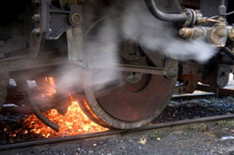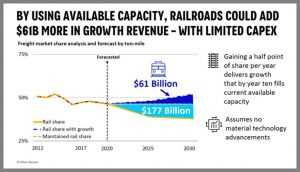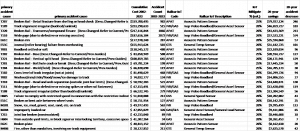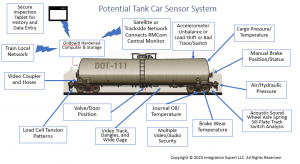Railroads and IoT – Part 3
Copyright © 2023 Integration Expert LLC. All rights reserved. More information: info@integrationexpert.com. The conclusions in this document represent our opinions supporting further study and proofs of technology.
What did I miss in Parts 1 and 2?
 The Ohio railway tragedy of 2023 has been traced to a serious mechanical problem in one of the railcars that has been recognized for over 100 years. We related a personal story about a resistance to instrumentation—specifically overheated axle bearings causing derailments—on railcars from decades ago. Railroads have many accidents from derailed cars, made more expensive and hazardous by carrying flammable and toxic cargoes.
The Ohio railway tragedy of 2023 has been traced to a serious mechanical problem in one of the railcars that has been recognized for over 100 years. We related a personal story about a resistance to instrumentation—specifically overheated axle bearings causing derailments—on railcars from decades ago. Railroads have many accidents from derailed cars, made more expensive and hazardous by carrying flammable and toxic cargoes.
In our opinion, we cannot expect much action from the railroad industry. In testimony to Congress in March 2023, Norfolk Southern’s CEO made minimal suggestions: minor changes to a 70-year-old trackside monitoring scheme called hot box detectors.
With the explosion of InternetOfThings (IoT) sensors, inexpensive video, and the Internet availability along every railway roadbed, the cost has never been lower.
The Federal Government should set up a Railcar Monitoring Command (RMCom) shared by the Commerce Department, DARPA, and the Federal Railroad Administration (FRA/DoT), a high-tech, FAA-like national organization to install, monitor, and manage this instrumentation.
Judging from the lack of response to Parts 1 and 2, perhaps avoiding accidents is not a strong enough incentive to change the railroads’ approach. Part 3 looks to the growing economic risk for the railroads, shippers, state/Federal governments, and the general public. Unresolved issues will only get worse from now on, particularly for international rail transport.
Also, look for Part4 regarding an evolutionary approach to Grade Crossings Using IoT.
Railroad accident losses are manageable, not ‘Black Swan’ events
The total loss for the 2023 East Palestine, Ohio derailment and fire is estimated at $380 million dollars. This amount is roughly equal to one year’s total railroad accident loss as measured by FRA/railroad statistics—an extraordinary impact on profit and insurers.
A Black Swan event is one whose impact cannot be predicted from past experience—what finance managers call unsystematic risk.
While some considered the 2008 US housing crisis to be a Black Swan, industry insiders raised alarms as early as 2006 that dangerous, growing vulnerabilities in the housing market needed to be managed or risk a financial disaster. East Palestine is not a Black Swan event; instead, it is a wake-up call for the railroad industry that risk of substantial losses could skyrocket.
Rail statistical risk factors include:
- Increased amounts and mix of hazardous chemicals
- Longer, faster, more stressed trains, track, and components
- Fewer railroad operations staff for inspections and operations
- Rail routes through high-risk areas such as water sources and urban locations
- Expense of or lack of insurance resources to handle multiple major liability events
- Lack of stepwise improvements such as braking system modernization
- Lack of or rollback of government regulations intended to increase safety margins
Some combination of the above factors resulted in East Palestine, a single derailment of hazardous chemicals that cost $387 million. A combination of well-known accident causes is what financial managers call systematic risk—multiplied by rapidly increasing costs to mitigate accidents with hazardous materials that are burning, hurting people, and/or spilled into waterways.
Losses from systematic risks can be decreased by a comprehensive approach to each risk factor. Railcar IoT can directly decrease several factors and contribute to a decrease in others.
The Railcar IoT Cost-Benefit Analysis for Decision Makers
Rail was the first major method of universal transport driving US commerce in the 1800’s. Rail enjoys major advantages of cost per mile per ton and decreases expensive wear on the US highway system. Rail increases overall safety by moving hazardous materials off highways.At the same time, we contend that rail is the revenue and risk laggard of the US transport supply chain. We further contend that a major factor is a lack of IoT metrics and monitoring at the railcar and sub-railcar levels. IoT addresses four high-risk financial trends for rail:
- IoT, like trucking, protects high-value cargoes by a combination of real-time location data coupled with video and audio security monitoring.
- IoT proactively warns operators of potential or imminent hardware failure to mitigate recovery cost for hazardous cargoes
- IoT hardens the security profile of high-value cargo carriers so that shippers of expensive items will feel more secure with security features rivalling competitors
- IoT monitors the condition of the surrounding environment such as roadbeds and hazards, providing maintenance experts with conditions between track and individual railcars.
We will examine four major cost benefit points:
- Opportunity for higher-value revenue growth
- Mitigate criminal activity and manage inventory better
- Avoid or mitigate very expensive hazardous spills
- Better operations through maintenance management.
We also discuss a potential ESG bonus for financial markets.
Each IoT-instrumented railcar pushes the rail industry toward the 21st century. Potential accident liability in populated downtown areas is astronomical, while railcar-level monitoring in 2023 is less expensive, more cost-effective, more comprehensive, and more scalable than ever before. Trains combine perhaps 100 cars with different ages, loads, inspection records, and issues. An inspector’s tablet could provide real-time railcar history/profiles. The WorldWideWeb + satellite infrastructure provides real-time access anywhere.
Railroads Can Transport Higher-Value If They Provide Better Monitoring and Security
Railway Age estimates that rail represents only about 10% of the trucking revenue. It also projects 53% transport revenue growth; however, most of the revenue growth will be in high-value products as opposed to 12% for cost-pressured bulk commodities. Trucking technology is racing forward with cargo sensors, intrusion detectors, GPS, and real-time video, audio, and communications.
A railcar is a valuable cargo carrier that connects into a finite transportation network of route segments, schedules, people, failure modes, and time. Delivery by rail can be slowed by any of these constraints,, a business issue that, if unaddressed, may favor competitors such as trucks.
Trucking has pushed forward with innovations to widen its lead over rail. In Boston Consulting Group’s Freight Rail’s Digital Future Is Just Around the Bend, under the heading Freight Rail Is Losing Market Share, Despite Advantages, the article says:The rail industry’s struggles to maintain service levels as the US emerges from the pandemic have only aggravated the challenges that have suppressed its share of the land-freight market over the past decade or so. From 2011 through 2020, rail transport’s share of that market shrank from 51% to 37%, mainly owing to a sharp decline in coal shipments. In that same decade, truck transport’s market share grew from 49% to 63%. This trend underscores a more basic problem: many shippers view rail as simply too hard to use compared with trucking. A key advantage of truck transport is the ability to provide end-to-end shipping, limiting the need to coordinate first and last-mile handoffs. The trucking industry has increased this advantage by adopting untethered GPS tracking technology for trailers and containers, giving shippers real-time visibility into the location of shipments.  The rail industry recognizes a potentially massive opportunity to replace trucking for cargoes traveling more than 750 miles. The Railway Age article cites a study by Oliver Wyman that suggests a 0.5% increase in high-value transport could result in major growth change for the railroad industry.
The rail industry recognizes a potentially massive opportunity to replace trucking for cargoes traveling more than 750 miles. The Railway Age article cites a study by Oliver Wyman that suggests a 0.5% increase in high-value transport could result in major growth change for the railroad industry.
Source: Railway Age and Oliver Wyman
Criminals 1: Railroads Should Better Manage Risk from Criminals Stealing Cargo
Hampering the growth of high-value cargo is a lack of railcar security. Every railcar represents a significant quantity of valuable material or packages. Most current crime involves breaking open railcars and stealing individual products—which is bad enough—but the possibility of stealing containers, intermodal trailers, or even entire railcars is possible for sophisticated criminal gangs.
According to the 2022 article Thieves loot freight trains in Los Angeles with impunity, “Dozens of freight cars are broken into every day on Los Angeles’s railways by thieves who take advantage of the trains’ stops to loot packages bought online, leaving thousands of gutted boxes and products that will never reach their destinations……..many major US mail order and courier companies such as Amazon, Target, UPS and FedEx are being hit by the thefts……….Rail operator Union Pacific has seen a 160% rise in the thefts in Los Angeles county since December 2020. “In October 2021 alone, the increase was 356% compared to October 2020,” UP said in a letter to local authorities. Mexico is a bellwether for higher rates of rail crime, including derailing trains to simplify robbery. (Photo: Los Angeles Times) According to Mexico Daily News, rail crime rose 74% in 2021, while train vandalism rose 43%. Commodities most stolen were grains, auto parts, domestic appliances, and minerals.
As a result, railcars appear to be soft, high-value targets for thieves, vandals, or saboteurs. IoT can monitor location, brake settings, and cargo status. IoT can provide both overt and covert video/audio monitoring, as well as even two-way communication like the intelligent doorbells on houses everywhere. Authorities gain valuable evidence to prosecute criminal gangs. Like the FAA, RMCom can coordinate with law enforcement agencies and provide monitoring capability for customers’ security teams cited above such as FedEx or Amazon. IoT can also drive railroad policy to reroute, reconfigure, and monitor trains through high-risk neighborhoods.
Criminals 2: Railroads Should Better Control Railcar Inventory Including Vandalism
Railcars are often left unattended on sidings or tracks. In FRA Announces Final Rule to Prevent Unattended Trains from Rolling Away, the Federal Railroad Administration acknowledges that even hazardous materials can be left unattended for extended periods without supervision. In 2015, a teenage vandal released the brakes on an unattended train that crashed at 40 MPH Into Utica’s Union Station, Causing Over $1 Million In Damages
Of course, IoT provides video deterrence and evidence for crime against unattended inventory.
Deadly Spills: Railroads Should Better Manage Risk of Highly Hazardous Cargoes
An April 2023 Pittsburgh CBS News story reported on a University of Pittsburgh study that of the 270 accidents in southwestern Pennsylvania in a 10-year period, 78% were within 300 yards of water. Why?
- Rail lines were built on relatively flat land—often adjacent to water
- Many major rail hubs/cities are located adjacent to water
- Steam locomotives of the 1800’s needed lots of water to operate.
22% (59) of the 270 accidents involved hazardous materials, often focused in more populous areas. As rail transport of hazardous liquids has increased, the threat of spills into critical watersheds and groundwater has risen exponentially. A derailment near the Allegheny River in May 2022 was not far from a drinking water intake for the city of Pittsburgh.
From Why Hazardous Train Derailments Happen, Who Pays, and How to Prevent Them:
What happened in East Palestine is one consequence of the United States’ commitment to hydrocarbon and petroleum resources, inadequate rail industry safety standards, a profit-maximizing railroad operational culture, and a broken rail disaster insurance market. As a consequence, hazardous petroleum resources have been increasingly transported by train, precipitating a rise in catastrophic derailments. Recent changes in federal rulemaking for rail safety technology also play a role. After the 2013 disaster in Lac-Mégantic, Quebec—which resulted in the death of 49 people—and numerous other petrochemical train disasters, the Department of Transportation (DOT) proposed requirements that railroads modernize braking systems for hazardous trains.
With pressure from the rail industry, the final 2015 rule was narrowly scoped to trains transporting crude oil, exempting other hazardous freight, including vinyl chloride. In 2017, the DOT rolled back this rule entirely in response to continued pressure from railroad and petroleum industries, reverting to previous brake technology standards in place since the 1860s.
Most of the largest Class I railroads employ the Precision Scheduled Railroading (PSR) industry practice, which cuts staff, increases train lengths, and streamlines delivery routes to reduce costs and maximize profits. Opponents of PSR say rail workers are stretched thin, geographic inspection regions have been expanded beyond what is safe or possible, and inspection frequency and quality are diminished as a result. Many catastrophic derailments in recent years resulted from inadequate inspections, like the 2016 Mosier, Oregon disaster, which the Federal Railroad Administration (FRA) found was caused by broken lag bolts that Union Pacific’s inspections missed.
IoT not only monitors metrics in the hazardous railcar, but the Palestine accident might have been averted if the seized bearing on any car had triggered a general train alarm.
Maintenance: Lower Overall Cost Via Targeted Benefit of Rolling Stock and Roadbeds
In a May 2023 Wall Street Journal article, truck tire manufacturers make the case that IoT can anticipate and intervene prior to tire failure in self-driving vehicles. They seem to have found a strong Cost Benefit case for preventing failure modes in unattended, high-value transportation vehicles.
Many of the challenges facing road vehicles have been addressed for rail except deployment. There is tight acoustic coupling between wheels, rails, and axles, allowing transducers to capture frequencies, oscillation, and interaction. Local signal processing can identify weakness or failure modes within the railcar while train- or system-level processing can anticipate failure for switch or track segments.
External sensors already exist for roller bearing defects. In ACOUSTIC DETECTION OF ROLLER BEARING DEFECTS: PHASE II, FIELD TEST, FRA tests of roadside sensors stated the following: “Envelope detected acoustic signatures (even from a single microphone) contain frequencies that are generated by defective internal bearing components. Spectrum of envelope detected acoustic signatures collected from wayside microphones contain peaks at (or near) the expected rotational frequencies of defective bearing components.” On-board sensors will have a major advantage in proximity, signal-to-noise, time-series data, and multi-sensor patterns. In other words, on-board sensors should work better.
One air carrier saved tens of millions per year in decreased downtime by monitoring and rescheduling preventive maintenance. Rail Cost Benefit can include decreased unscheduled disruption, better on-time delivery, fewer failure modes, decreased cost of remote failure occurrence, and real-time reporting of problems by field personnel such as leaky valves, misaligned couplers, or cracked sill plates.
Train operations depend upon a complex system of interactions between railcar condition, physical and human environment, schedule expectations, and cargo properties. Weak points or weakest links destroy efficient systems, break critical paths, and increase expense—often in the least accessible, most expensive, most time-sensitive situations.
Modernization Financial Bonus: Environment, Social, Governance (ESG) Investing
ESG as an investment strategy translates non-financial organization responsibilities into financial valuation that can be compared across companies and industries. Safeguarding the environment, managing social relationships, and responsible corporate governance all contribute to higher ESG valuation. ESG has become an important evaluation tool for institutional investors. Railcar IoT provides major narratives for each ESG leg:
- Environment: Track routes often follow waterways and pass directly through populated areas. Carriers can cite IoT to avoid expensive environmental disasters. Human-, automated-, or AI-driven train management will be more efficient with real-time and statistical IoT.
- Social: Railcar IoT can detect any of several acute problems like rising bearing journal temperature so that trains can be stopped and remediated before accidents happen. Accelerometers can determine oscillations across multiple cars that will alert maintenance crews to serious track maintenance. Latent railcar failure modes specific to individual railcar or cargo type can be diagnosed quickly. Video can scan roadbeds, watch for hazards/vandalism, and even look forward to grade crossings to manage neighborhood hazards.
- Governance: As our Chief Audit Officer used to say, “You only get what you inspect; not what you expect.” Stronger governance and mitigation of environmental and social risks are only available through stronger, near-real-time instrumentation that can be easily modified and enhanced.
From Why Hazardous Train Derailments Happen, Who Pays, and How to Prevent Them:
Taxpayers often bear the costs of worst-case catastrophes, and residents in small towns like East Palestine—where most catastrophic derailments have occurred—experience the environmental, economic, and social costs but have limited resources to prepare, respond, and recover.
Airlines and trucking already know these ESG lessons. Sensors and support equipment are available off-the-shelf. Rail already has high-speed internet next to roadbeds so networking is a sunk cost.
As better IoT tracking makes rail more competitive with trucking, cargoes carried by rail are more carbon-efficient and lower Implied Temperature Rise (ITR), adding to its ESG financial valuation.
Cost Benefit: Back of the Envelope Summary
In this analysis, we found that metrics are difficult to quantify, either published for a limited geographic area or the issues were addressed qualitatively.
In RANKING RISK FACTORS IN FINANCIAL LOSSES FROM RAILROAD INCIDENTS: A MACHINE LEARNING APPROACH, the following graph estimates the costs and incidence of railroad accidents:
 Note: “Financial losses’ only include railroad-specific damages to on-track equipment, signals, track, track structures, and roadbed. However, there are some other significant financial factors which are not considered while estimating the actual financial damage from a rail accident. Such expenses include delays, re-routing, emissions, cargo losses, first and emergency responders, and other operating costs. From the graph, one could interpolate that East Palestine represents the equivalent of roughly an entire year, or 2,000 ‘average’ accidents; however, the graph does not represent the entire extended cost of remediation and cleanup of groundwater, businesses, and residences.
Note: “Financial losses’ only include railroad-specific damages to on-track equipment, signals, track, track structures, and roadbed. However, there are some other significant financial factors which are not considered while estimating the actual financial damage from a rail accident. Such expenses include delays, re-routing, emissions, cargo losses, first and emergency responders, and other operating costs. From the graph, one could interpolate that East Palestine represents the equivalent of roughly an entire year, or 2,000 ‘average’ accidents; however, the graph does not represent the entire extended cost of remediation and cleanup of groundwater, businesses, and residences.
It also does not represent the potential return from innovative technologies like IoT.
Like the graph, legal protections and liability limits seem to have shifted costs from railroads to third parties such as shippers, insurers, governments, or local communities. Costs such as environmental cleanup may last for years. We know that the costs are significant because shipping miles are very high, incidence numbers are statistically significant, and increases in each statistical factor contribute to dramatic increases in overall accident cost.
This analysis only analyzes railcar IoT. Locomotive IoT should already be in railroad budgets, even though IoT advances for railcars can benefit locomotives as well. Theft of rails is not considered even though it occurred over 4,000 times in Mexico in 2021.
As we discussed in Part 2, the Federal Government should set up a Railcar Monitoring Command (RMCom), a high-tech, FAA-like national organization to install, monitor, and manage this instrumentation:
- RMCom will be industry-wide and cross-border. RMCom will create secure flows of information between FRA, DoD, FAA, university researchers, and national railroads
- Federal and state governments have been absorbing excess, collateral, and uninsured costs resulting from railroad accidents for years.
- Railroads have been resistant to innovation
- A Federal organization will be more transparent with information
Cost Benefit Area
Figure 1 is a general list of sensors that could be used to mitigate classes of accidents.
In Figure 2, the first analysis tracked conservative $estimates of the losses sustained from 55,235 accidents is $6.8 Billion—average $341 million per year— with 376 different accident codes between 2002 and 2022. We hypothesized a 20% drop in a subset of 136 codes that have an IoT sensor defined; 73 were locomotive-specific; 59 were human factors related; 113 were labeled To Be Determined in future discussions. The top 130 codes for which an IoT approach was suggested resulted in a $732 million positive effect on 4,593 fewer accidents over 20 years.
This preliminary analysis indicates a decent cost benefit even in the absence of major accidents like East Palestine. If the crime rate starts to approach that of Mexico’s or bad actors start a concerted anti-infrastructure campaign, or Palestine events increase, this program will move from cost benefit to perhaps military strategic. The rest of the transportation market already embraces IoT, analyses, and benefits; rail as a strategic resource is still in the past. The next step for this analysis is to build failure and operational loss stats models for train and railcar scenarios for simulation. On the other side, expense and deployment estimation for the railcar fleet would start a ROI analysis. Replacement of trucking cargoes can impact road maintenance. Regulatory, military, and ESG factors should also tip the scales on legal and strategic considerations. This complex web of costs and benefits suggests a cost-sharing model between railroads, insurers, government, railcar owners, and even shippers—to be determined as the project progresses.
Figure I: Potential Railcar IoT Sensor Technology

Figure II: Top 20 FRA Accident Codes by Total Loss Mapped to Sensor Technology

Figure III: Potential Tank Car Sensor System
